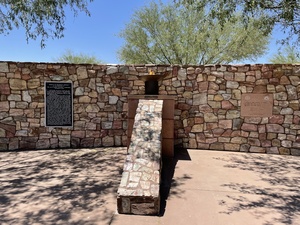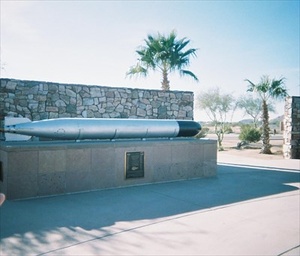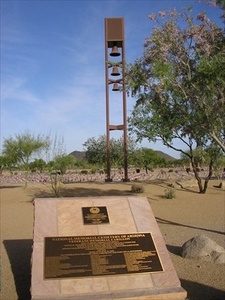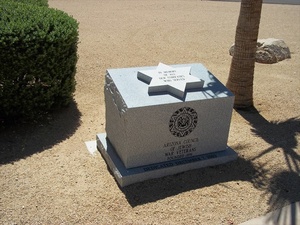NATIONAL MEMORIAL CEMETERY OF ARIZONA
National Memorial Cemetery of Arizona, aka Arizona Veterans Memorial Cemetery, is a United States of America National Cemetery. It is located in Phoenix, Arizona, and encompasses 225 acres (91 ha). Over 78,000 veterans and their spouses are memorialized at the site. It is one of two national cemeteries in Arizona (the other is Prescott National Cemetery). Burial in this national cemetery is open to all members of the armed forces who have met a minimum active-duty service requirement and were discharged under conditions other than dishonorable.
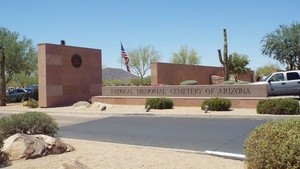 National Memorial Cemetery of Arizona
National Memorial Cemetery of Arizona
CEMETERY'S MISSION
“Our mission is to honor veterans and their families with final resting places in national shrines and with lasting tributes that commemorate their service and sacrifice to our nation,” administrative officer Deborah Ryan of the Department of Veterans Affairs says. “It's a peaceful and serene setting with panoramic views of the mountain.”
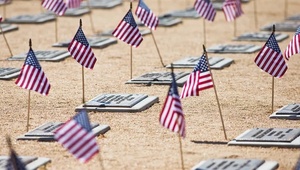 Photo Credit Tom Tingle/The Republic
Photo Credit Tom Tingle/The Republic
HISTORY
A state law passed by Governor Raul Hector Castro in 1976 established a prominent veterans' cemetery. Located in Phoenix, AZ, the cemetery was dedicated on December 9, 1978, with the first interments taking place the following spring. Control of the cemetery was officially transferred to the United States Department of Veterans Affairs, allowing it to become a National Cemetery in 1989. In 1999 over 13 million dollars was spent on improving the facilities and developing the area with the intent of serving the burial needs of veterans until the year 2030.
NOTABLE MONUMENTS & MEMORIALS
Eternal Flame Monument
This eternal flame memorializes all our fallen heroes. It is located in the main section of the National War Memorial Cemetery of Arizona.The text located on the monument reads, “In honor of these defenders of freedom for whom Taps have sounded now burns the flame eternal” Dedicated by American Legion, American Legion Auxiliary, Sunnyslope Post 75
World War II Submarine Torpedo Monument
This monument, topped by a torpedo, honors those who served and died on board submarines. One plaque specifically mentions the USS Perch US 176, scuttled by her crew on March 3, 1942. Some of them later died in POW camps. Another plaque lists 52 submarines sunk and "still on patrol."
The Vietnam Veterans Memorial [Field Cross Memorial
John Smither of Eldorado Springs, Mo., designed the initial rendering. After several years, Brown found Larry Peters and worked with him to complete Smither’s basic design. Peters and Dusty Rhoades and Terry Nolan wrote a letter to the Arizona State Council introducing the bronze, titled initially “Tranquil Ground.” Brown said the piece communicates a sense of honor and healing and is an appropriate memorial for veterans of the Vietnam War, both living and dead.
The bronze symbolizes the ultimate cost of war, powerful in its imagery yet subtle execution. This piece neither glorifies war nor condemns it. A plaque reads: “In memory of all who served in Vietnam at great cost and of those brave men and women whose lives were lost.”
The memorial was donated by VVA Phoenix Chapter 432 and Veteran Friends of Arizona and dedicated on September 22, 2001, at the National Memorial Cemetery of Arizona.
“This will not only serve as a monument to those lost in Vietnam,” Brown said, “but also as a symbol of the American spirit.”
Navy Seabees Veterans of America
The Navy Construction Battalion, better known as the Seabees, was responsible for constructing most of both the temporary and permanent infrastructure at U.S. military locations around the world. This memorial was created to honor all Seabee's past, present, and future. The marker text reads, “With compassion for others we build we fight for peace with freedom Navy Seabees Veterans of America Can Do Dedicated to all Seabees past present and future. The monument was dedicated on November 11, 2006.
Veterans Memorial Carillon
This carillon was dedicated on May 26, 2008, as a living memorial to American veterans who served their country honorably for the cause of freedom. The carillon rises above the serene landscape of the cemetery. It can be seen from anywhere in the cemetery. It is one of several memorials that can be found within this veteran's cemetery. Donated by AMVETS National Service Organization, Unified Arizona Veterans, and Az Department of Veteran Services.
The Arizona Women Veterans' Memorial - Invisible Soldier Image
This memorial is a poignant dedication to the women who served for multple decades in the military. The text on the marker reads The Arizona Women Veterans' Memorial "Women veterans serving together - Past, Present and Future" Words on the plaque are written in the main body of the text. This is one of many memorials located around a central focal point: a flag mast from a famous battle.
Jewish War Veterans Memorial
Located along a short sidewalk lined with many memorials for the various armed services, this honors Jewish veterans. The marker text reads, “In memory of all our comrades who served. Arizona Council of Jewish War Veterans was founded in 1896. Dedicated on December 7, 2003, the memorial was placed there by the Arizona Council of Jewish War Veterans.
NOTABLE INTERMENTS
The Last Surviving Veteran of the Spanish-American War.
Nathan E. Cook (October 10, 1885 – September 10, 1992) was a sailor in the United States Navy during the Philippine–American War. His naval career continued through the Second World War, and upon his death, at the age of 106, he was the oldest surviving American war veteran. Nathan was born on October 10, 1885, in Hersey, Michigan. He left a 50-cent-a-day job at a packing plant in a city in Kansas after seeing a recruiting poster that said, "Join the Navy and See the World." He was later assigned to the USS Pensacola.
Navajo Code Talkers
National Memorial Cemetery of Arizona is the final resting place for several esteemed Navajo Code Talkers. Their knowledge of the Navajo language and skill in transmitting essential coded messages helped to thwart enemy eavesdroppers during World War II. In 2001, the Navajo Code Talkers were presented with the Congressional Silver Medal.
Sidney Bedoni, a native of Arizona, enlisted in the U.S. Marine Corps on October 20, 1942, at 16. PFC Bedoni was a Navajo Code Talker in the Pacific Theater during World War II and served until January 18, 1946. Bedoni reenlisted in the Army on April 21, 1948, and fought during the Korean War. In 1988, Bedoni was promoted to sergeant major for his service. Bedoni, the last surviving Navajo Code Talker paratrooper, died June 8, 2014 (Section 55, Site 3611).
Richard Dooley, a native of Arizona, enlisted in the U.S. Marines on October 10, 1942. Cpl. Doolie was a Navajo Code Talker in the Pacific Theater during World War II and served until December 26, 1945. He died on December 24, 1982 (Section 12, Site 2232).
Arthur J. Hubbard Sr., a Navajo and native of Arizona, served in the U.S. Marine Corps (1939-1945). Pvt. Hubbard instructed Code Talkers during World War II. Hubbard became the first American Indian elected as an Arizona state senator (1972-1984) and he contributed to the establishment of the Navajo Nations first college, Diné College. He died February 7, 2014 (Section 55, Site 3882).
Joe Kellwood, a native of Arizona, was born in 1921 and enlisted in the U.S. Marine Corps in October 1942. PVT First Class Kellwood served in World War II with the 1st Marine Division in the Pacific Theater. Kellwood saw action at Cape Gloucester, Peleliu, and Okinawa, and he continued as a Navajo Code Talker through the war's end. After the war, Kellwood returned to Arizona, active in veterans' organizations. He died on September 5, 2016 (Section 52, Site 161).
Robert "Bert" Tallsalt of Arizona enlisted in the U.S. Marine Corps on October 27, 1944 and served as a Navajo Code Talker in the Pacific Theater during World War II. After returning home, Tallsalt took a leadership role in the community as a councilman representing Navajo Mountain and as an educator. He received his degree from Utah State University and taught at the Intermountain School in Brigham City, Utah. Tallsalt was active in the Navajo Code Talkers Association until he died in 2003 (Section 18D, Site 2662).
Sports & Entertainment
Doyle "Porky" Lade (February 17, 1921 – May 18, 2000) was a Major League Baseball pitcher who pitched for the Chicago Cubs from 1946 to 1950. After the 1942 season ended, Lade signed up for military service and spent the next few years as a member of the United States Coast Guard.[5] When he returned to the White Sox for the 1946 season, he was placed on the original major league roster but began the season for Shreveport instead. On July 9, 1946, the Chicago Cubs purchased Lade's contract from the Chicago White Sox. In his time in the minors in 1946, he won 12 games and pitched 32 consecutive scoreless innings at one time.
Lee William Aaker, Actor (September 25, 1943 – April 1, 2021)[1] was an American child actor, producer, carpenter, and ski instructor known for his appearance as Rusty of "B-Company" in the 1950s television program The Adventures of Rin Tin Tin. He was the final surviving cast member of the series. As a young child of 8 , he started appearing uncredited in films such as The Greatest Show on Earth (1952) and High Noon (1952).He also appeared in other film styles such as the film noir thriller Jeopardy (1953) with Barbara Stanwyck, the horse opera drama Arena (1953) with Gig Young, and the comedies Mister Scoutmaster (1953) with Clifton Webb and Ricochet Romance (1954) with Marjorie Main.
Political Leaders
Evan Mecham, former governor of Arizona May 12, 1924 – February 21, 2008)[1] was an American businessman and the 17th governor of Arizona, serving from January 5, 1987, until his impeachment conviction on April 4, 1988. A decorated veteran of World War II, Mecham was a successful automotive dealership owner and occasional newspaper publisher.[2]
Periodic runs for political office earned him a reputation as a perennial candidate and the nickname "The Harold Stassen of Arizona" before he was elected governor under the Republican banner.[3] As governor, Mecham was plagued by controversy almost immediately after his inauguration. He became the first U.S. governor to face removal from office through impeachment, a scheduled recall election, and a felony indictment.[4] He was the first Arizona governor to be impeached.
Eldon Rudd, A former member of the United States House of Representatives, Rudd was born in Camp Verde, Arizona. A 1939 graduate of Clarkdale High School in Clarkdale, Arizona, enlisted in the United States Marine Corps in 1942 and served as a fighter pilot during World War II. After his discharge in 1946, he attended Arizona State College, from which he graduated in 1947, and the University of Arizona Law School.
Hours of Operation/Contact Information
Office Hours: Monday thru Friday 8:00 a.m. (MT) - 4:30 p.m. (MT)
Closed federal holidays except Memorial Day.
Visitation Hours: Open daily from sunrise to sunset.
Address: 23029 N Cave Creek Rd, Phoenix, AZ 85024
Phone: (480) 513-3600
References
https://www.cem.va.gov/cems/nchp/nmca.asp (VA Cemetery Site)
https://www.azcentral.com/story/news/arizona/2014/06/10/navajo-code-talker-dies-abrk/10251029/ (AZ Central/Navajo Code Talkers)
https://www.waymarking.com/waymarks/WM90ZV_Navy_Seabees_Veterans_of_America (Waymarks/Seabees)
https://www.waymarking.com/waymarks/wm932X_Veterans_Memorial_Carillon_Phoenix_Arizona (Waymarks/Carillon)
https://www.waymarking.com/waymarks/wm90ZQ_The_Arizona_Women_Veterans_Memorial_Invisible_Soldier (Women Veterans Memorial)
https://www.waymarking.com/waymarks/wm90ZJ_Jewish_War_Veterans_Memorial (Jewish War Memorial)
https://www.waymarking.com/waymarks/wm3HJT_Shadow_Mountain_Mortuary_Eternal_Flame_in_Phoenix_AZ (Eternal Flame Memorial)
https://vvaveteran.org/36-4/36-4_notes4.html
https://en.wikipedia.org/wiki/Lee_Aaker

